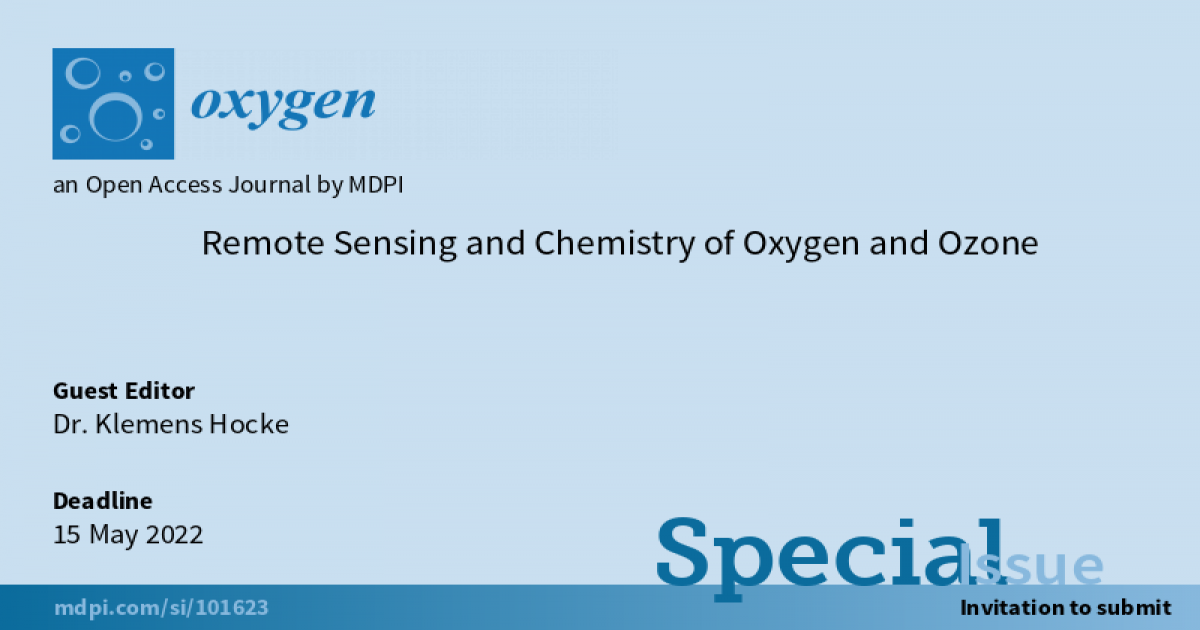- Tracked forImpact Factor
- 8.4CiteScore
- 25 daysTime to First Decision
Remote Sensing and Chemistry of Oxygen and Ozone
Special Issue Information
Dear Colleagues,
We would like to invite contributions about remote sensing and chemistry of oxygen and ozone in the Earth’s atmosphere, planetary atmospheres of the solar system, exoplanetary atmospheres, comets, starforming regions and other places in the universe. This Special Issue will reveal synergies and new aspects of the different remote sensing techniques and their applications. In the Earth’s atmosphere, long-term monitoring of the ozone layer is important for mankind, as well as remote sensing of tropospheric ozone. Oxygen and ozone are essential for biology, chemistry, energetics and the study of the dynamics of the Earth and its atmosphere. Remote sensing of oxygen isotopes enhances our knowledge about the circulation of the atmosphere and the age of air. Airglow and auroral emissions of atomic and molecular oxygen inform about tides, gravity waves, vertical winds, chemical and energetical processes in the middle and upper atmosphere. Indirect measurement of oxygen ions by incoherent scatter radars provides information about temperature, density and winds in the thermosphere and ionosphere. Oxygen and ozone are regarded as biosignatures, rendering the detection of oxygen and ozone in planetary and exoplanetary atmospheres an exciting challenge. The design of new space missions, telescopes, spectrometers and retrieval techniques for finding the weak signals of oxygen and ozone in space are driven by the search for extraterrestrial life and habitability.
Dr. Klemens Hocke
Guest Editor
Manuscript Submission Information
Manuscripts should be submitted online at www.mdpi.com by registering and logging in to this website. Once you are registered, click here to go to the submission form. Manuscripts can be submitted until the deadline. All submissions that pass pre-check are peer-reviewed. Accepted papers will be published continuously in the journal (as soon as accepted) and will be listed together on the special issue website. Research articles, review articles as well as short communications are invited. For planned papers, a title and short abstract (about 250 words) can be sent to the Editorial Office for assessment.
Submitted manuscripts should not have been published previously, nor be under consideration for publication elsewhere (except conference proceedings papers). All manuscripts are thoroughly refereed through a single-blind peer-review process. A guide for authors and other relevant information for submission of manuscripts is available on the Instructions for Authors page. Oxygen is an international peer-reviewed open access quarterly journal published by MDPI.
Please visit the Instructions for Authors page before submitting a manuscript. The Article Processing Charge (APC) for publication in this open access journal is 1000 CHF (Swiss Francs). Submitted papers should be well formatted and use good English. Authors may use MDPI's English editing service prior to publication or during author revisions.
Keywords
- observations
- simulations
- remote sensing technique and in situ measurement
- retrieval technique
- cross-validation of remote sensing and chemical sensors
- science and applications
- atmospheric oxygen
- atmospheric ozone
- circulation, dynamics and energetics
- biology
- chemistry
- spectroscopy

Benefits of Publishing in a Special Issue
- Ease of navigation: Grouping papers by topic helps scholars navigate broad scope journals more efficiently.
- Greater discoverability: Special Issues support the reach and impact of scientific research. Articles in Special Issues are more discoverable and cited more frequently.
- Expansion of research network: Special Issues facilitate connections among authors, fostering scientific collaborations.
- External promotion: Articles in Special Issues are often promoted through the journal's social media, increasing their visibility.
- e-Book format: Special Issues with more than 10 articles can be published as dedicated e-books, ensuring wide and rapid dissemination.

